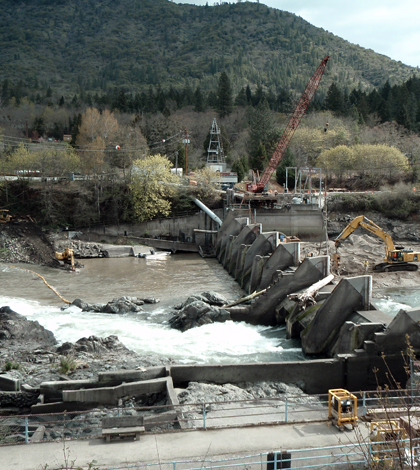Study of Oregon dam removals finds rivers recover quickly

Savage Rapids Dam removal on the Rogue River in Oregon (Credit: River Engineering & Restoration Lab)
As dams age and ecosystem recovery becomes an increasing management priority, dam removal is becoming a common practice. Removing dams tends release a slug of accumulated sediment to the river downstream, which sometimes raises concern over the impacts of removal projects on habitat, flooding, and infrastructure.
But the concern over those catastrophic impacts seemed inflated to Desirée Tullos, an associate professor of water resources engineering at Oregon State University. Tullos’ new study in the journal PLOS ONE offers evidence that, from a biological and physical perspective, there isn’t much evidence to back up those concerns. Based on a study of dam removals on two Oregon rivers, it appears that sediment moving downstream is only a quick speed bump on the road to recovery to a pre-dam state.
“We’ve been seeing this happen anecdotally over the years, but this is among the first solid evidence we can show that these impacts are actually quite small and the recovery is really quick,” she said.
The study followed the Rogue and Calapooia rivers through dam removals, surveying downstream biological communities and physical characteristics of the channel before and after deconstruction. Prior to dam removal, insect communities at sites below the dams were in worse shape than sites upstream of the dams’ influence. But within a year after removal, insects recovered from the pulse of sediment and the dam’s long-term influence to look more like upstream biological communities.

Heavy equipment takes down a dam on the Calapooia River (Credit: River Engineering & Restoration Lab)
The physical effects of the sediment on each river’s riffles and pools persisted longer than the biological effects, but still showed signs of a relatively quick recovery.
The finding that the biology recovered more rapidly than the physical components of the system was a surprise, Tullos said.
“That’s important for folks that are concerned about ecological impacts of dam removal,” she said. “We don’t have to wait for the physical system to look like it did historically before the aquatic ecosystem can recover.”
The dams removed were the Brownsville Dam on the Calapooia and the Savage Rapids Dam on the Rogue. The Calapooia River is smaller and wadeable, while the larger Rogue required the researchers to take to a 16-foot whitewater raft through rapids to get the sampling done.
“It’s one of the primary reasons I love working on rivers,” Tullos said. “I care about them deeply, but also because the field work is usually really fun.”

Surveying the land around the Savage Rapids Dam removal (Credit: River Engineering & Restoration Lab)
That rivers recover quickly from dam removals is good news for the long list of streams blocked by aging structures that are in poor condition or have outlived their usefulness and no longer provide the benefits they were built to provide.
“We need to acknowledge that our infrastructure is all temporary. None of it is permanent and there’s a paradigm shift needed for how we think about things,” Tullos said. “In the meantime, we can probably breathe a collective sigh of relief that, for some river systems, the negative impacts of dams doesn’t appear to be permanent.”
Top image: Savage Rapids Dam removal on the Rogue River in Oregon. (Credit: River Engineering & Restoration Lab)




0 comments